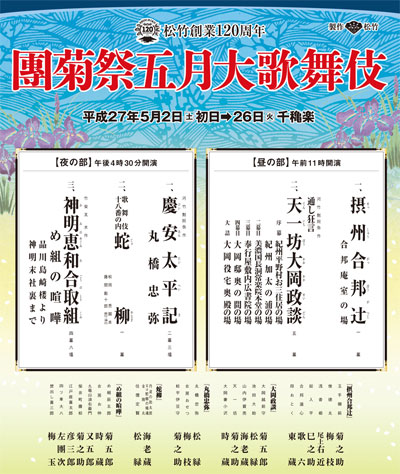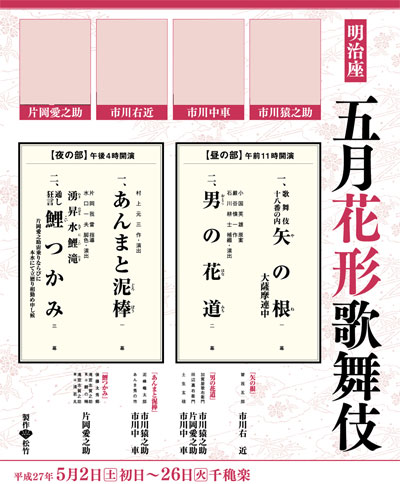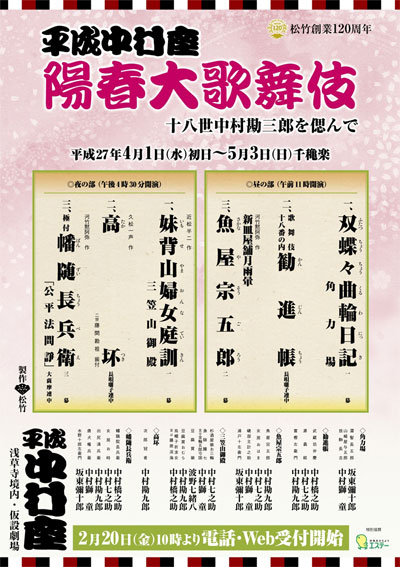| MAY 2015 |
|
7 shows in T˘ky˘ (Kabukiza, National Theatre, Meijiza, Heisei Nakamuraza), 1 show in ďsaka (Sh˘chikuza), 1 show in Ky˘to (Minamiza) and 1 tour (New Green Leaves)!
|
| Kabukiza (T˘ky˘) |  |
| Dates | 2 ~ 26 May 2015 (Dankikusai Gogatsu ďkabuki) Dankikusai May Grand Kabuki |
| MatinÚe | |
| Evening | |
| Casting |
Living National Treasure Onoe Kikugor˘, Ichikawa Ebiz˘, Nakamura Tokiz˘, Onoe Kikunosuke, Nakamura Baigyoku, Ichikawa Sadanji, Onoe Sh˘roku, Band˘ Hikosabur˘, Nakamura T˘z˘, Nakamura Karoku, Nakamura Matagor˘, Ichimura Kakitsu, Ichikawa Unosuke, Kataoka Ichiz˘, Kawarasaki Gonjűr˘, Band˘ Shűch˘, Band˘ Kamesabur˘, Band˘ Kametoshi, Sawamura Yoshijir˘, Sawamura S˘nosuke, Ichikawa Kudanji, Arashi Kitsusabur˘, Kataoka Matsunosuke, Ichimura Kitsutar˘, Nakamura Baishi, Nakamura Kash˘, Band˘ Minosuke, Nakamura Mantar˘, Ichimura Takematsu, ďtani Hirotar˘, ďtani Hiromatsu, Nakamura Yonekichi, Nakamura Takanosuke, Nakamura Hayato, Nakamura Tanenosuke, Ichikawa Otora, Onoe Ukon |
| Comments |
The great yearly Dankiku festival for the Naritaya and Otowaya guilds, which commemorates 2 great stars of the Meiji era: Dan = Ichikawa Danjűr˘ IX and Kiku = Onoe Kikugor˘ V.
|
 |
| Meijiza (T˘ky˘) |  |
| Dates | 2 ~ 26 May 2015 (Gogatsu Hanagata Kabuki) May Young Actors Kabuki |
| MatinÚe |
Otoko no Hanamichi |
| Evening |
Anma to Dorob˘ Waki Noboru Mizu-ni Koi Taki (Koi Tsukami) |
| Casting |
Ichikawa Ennosuke, Kataoka Ainosuke, Ichikawa Chűsha, Ichikawa Ukon, Kataoka Hidetar˘, Band˘ Takesabur˘, Ichikawa Monnosuke, Nakamura Kikaku, Ichikawa En'ya, Ichikawa Emiya, Nakamura Kikaku, Ichikawa Omez˘, Ichikawa Juen, Nakamura Kazutar˘, Ichikawa K˘tar˘ |
| Comments |
A Kabuki program at the Meijiza with Ichikawa Ennosuke as zagashira.
|
 |
| Heisei Nakamuraza (T˘ky˘) | |
| Dates | 1 April ~ 3 May 2015 (Y˘shun ďkabuki) Full Spring Merriness Grand Kabuki |
| MatinÚe | |
| Evening | |
| Casting |
Nakamura Kankur˘, Nakamura Shichinosuke, Nakamura Hashinosuke, Band˘ Yajűr˘, Nakamura Shid˘, Kataoka Kamez˘, Nakamura Kotar˘, Band˘ Shingo, Nakamura Tsurumatsu, Nakamura Kunio, Nakamura Muneo, Nakamura Yoshio, Namino Naoya |
| Comments |
The Heisei Nakamuraza is back next year in T˘ky˘ in Asakusa. There was no Heisei Nakamuraza in T˘ky˘ for 3 years, following the sudden death of its creator Nakamura Kanzabur˘ XVIII. The new zagashira is Nakamura Kankur˘.
|
 |
| National Theatre (T˘ky˘) |
| Dates | 9 ~ 20 May 2015 (Zenshinza Gogatsu K˘en) Zenshinza May Performances |
| Program | |
| Casting |
Nakamura Umenosuke, Arashi Keishi, Kawarasaki Kunitar˘, Fujikawa Yanosuke, Arashi Yoshisabur˘, Yamazaki Ryűnosuke, Yamazaki Tatsusabur˘ |
| Comments |
The usual Zenshinza May program at the National Theatre!
|
|
|||
| Dates | 8 ~ 14 May 2015 (Kabuki Kansh˘ Ky˘shitsu) Kabuki Appreciation Class |
||
| Program |
Minamiza to Kabuki |
||
| Casting | |||
| Comments |
23rd edition of a pedagogical show in Ky˘to combining explanation for beginners (done by the professional storyteller Katsura Kujaku) and the dance-drama "Iro Moy˘ Chotto Karimame".
|
||
| New Green Leaves Tour | |
| Dates | 14 ~ 31 May 2015 (Shinroku Tokubetsu K˘en) New Green Leaves Special Performances |
| Program |
Goaisatsu Onna Kurumabiki |
| Casting |
Nakamura Kankur˘, Nakamura Shichinosuke, Band˘ Shingo, Nakamura Tsurumatsu |
| Comments |
A special and short tour in 12 cities led by the two heirs of the Nakamuraya guild and their disciples.
|
| Sh˘chikuza (ďsaka) |
| Dates | 3 ~ 26 May 2015 (Band˘ Tamasabur˘ Tokubetsu K˘en) Band˘ Tamasabur˘ Special Performances |
| Program |
Amaterasu |
| Casting | |
| Comments |
Living National Treasure Band˘ Tamasabur˘ and the Kod˘ taiko drummers revive "Amaterasu", which was staged for the first time in May 2006 at the Minamiza [more details]. |
|
|
| Contact | Main | Top | Updates | Actors | Plays | Playwrights | Programs | Links | FAQ | Glossary | Chronology | Illustrations | Prints | Characters | Derivatives | Theaters | Coming soon | News |